Volete aggiungere la paginazione numerica al vostro tema WordPress?
Come predefinito, i temi di WordPress aggiungono i colleghi Next / Previous in fondo alle pagine degli archivi. Il problema è che non sono molto facili da usare per gli utenti. Per questo motivo, molti blog famosi utilizzano la paginazione numerica per facilitare la navigazione delle pagine di archivio.
In questo articolo vi mostreremo come aggiungere la paginazione numerica nel vostro tema WordPress.
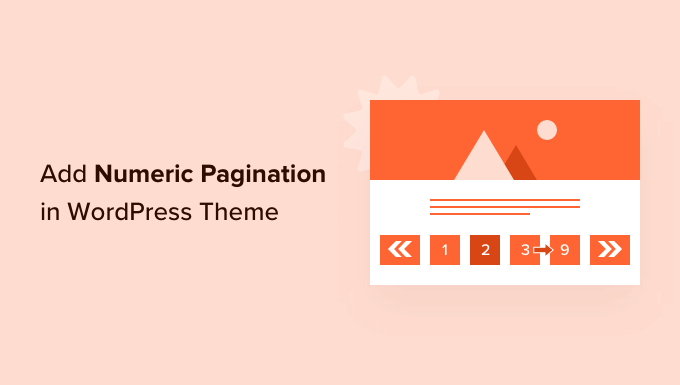
Perché aggiungere la paginazione numerica nel tema WordPress?
La maggior parte dei temi ha una pagina di archivio che mostra un elenco di articoli. Man mano che si pubblicano altri articoli del blog WordPress, la pagina dell’archivio si estende su più pagine.
I colleghi di paginazione aiutano i visitatori a spostarsi tra le pagine dell’archivio e di solito appaiono nella parte inferiore del sito web WordPress.
Alcuni temi di WordPress utilizzano i colleghi “Articoli meno recenti” e “Articoli più recenti” per la paginazione. Tuttavia, questo permette al visitatore di spostarsi in avanti e indietro solo di una pagina.
Inoltre, non mostra la posizione attuale del visitatore nell’archivio. Questo può rendere più difficile ai visitatori la navigazione nell’archivio del blog.
È qui che entra in gioco la paginazione numerica.
Invece di mostrare i colleghi “Più vecchio” e “Più nuovo”, la paginazione numerica mostra una serie di numeri che permettono ai visitatori di saltare a una pagina specifica dell’archivio.
La paginazione numerica può anche utilizzare delle evidenziazioni o dei colori diversi per mostrare il numero della pagina corrente, in modo che il visitatore sappia sempre esattamente dove si trova nell’archivio.
In WPBeginner, utilizziamo la paginazione numerica e mettiamo in evidenza il numero della pagina corrente in arancione. Inoltre, forniamo collegamenti diretti alle 4 pagine che circondano la pagina corrente del visitatore.
Abbiamo anche un collega all’ultima pagina del nostro archivio, in modo che i visitatori possano vedere rapidamente e facilmente i nostri primi articoli, come si può vedere nell’immagine seguente.
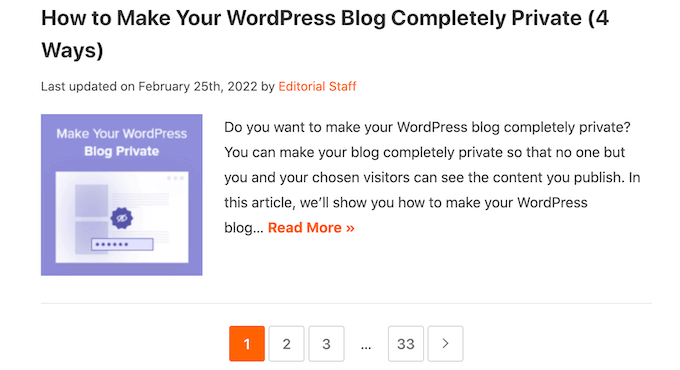
Secondo la nostra esperienza, questo tipo di paginazione numerica rende il sito più facile da navigare rispetto ai collegamenti predefiniti “Articoli meno recenti” e “Articoli più recenti”.
Se il tema WordPress ha la paginazione “Older” e “Newer”, consigliamo sempre di sostituirla con una paginazione numerica.
In questa guida copriremo due modi diversi per aggiungere la paginazione numerica nel vostro tema WordPress. Se preferite passare direttamente a un metodo particolare, potete utilizzare i colleghi qui sotto.
- Metodo 1. Come aggiungere la paginazione numerica in WordPress utilizzando WP-PageNavi
- Metodo 2. Come aggiungere manualmente la paginazione numerica nel tema di WordPress
Metodo 1. Come aggiungere una paginazione numerica in WordPress usando WP-PageNavi
Il modo più semplice per aggiungere la paginazione numerica in WordPress è utilizzare il plugin WP-PageNavi.
Per utilizzare questo plugin, dovrete comunque apportare alcune modifiche al codice del vostro tema, ma è molto più facile rispetto al metodo del codice completo, perché WP-PageNavi vi dà il controllo completo sulla paginazione del vostro sito.
La prima cosa da fare è installare e attivare il plugin WP-PageNavi. Per maggiori dettagli, consultate la nostra guida passo passo su come installare un plugin di WordPress.
Dopo aver attivato il plugin, andare su Impostazioni ” PageNavi per configurare le impostazioni del plugin.
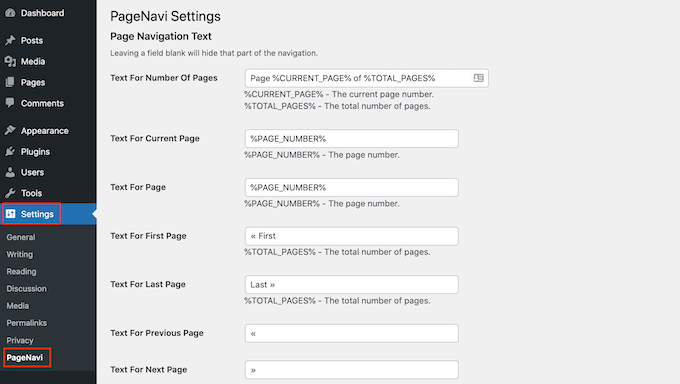
Qui è possibile sostituire il testo predefinito della paginazione con un testo proprio. Ad esempio, è possibile modificare il testo che il sito web utilizza per i colleghi “Prima pagina” e “Ultima pagina”.
È possibile personalizzare anche i link della paginazione numerica.
Nella sezione “Numero di pagine da mostrare” è possibile scegliere quante pagine il plugin mostrerà nella sezione di paginazione del sito web.
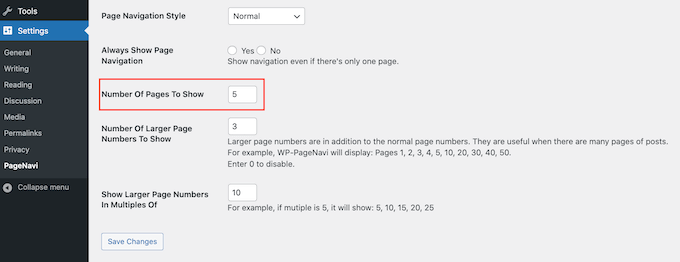
L’impostazione predefinita è 5, il che significa che WP-PageNavi mostrerà i collegamenti diretti a 5 pagine.
Come si può vedere nello screenshot qui sotto, se ci si trova sulla pagina 4, si vedranno i colleghi alle pagine 2, 3, 4, 5 e 6.
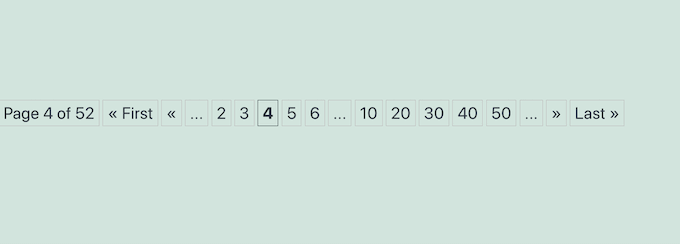
È possibile che si vogliano mostrare più pagine o meno pagine. Per modificare questa impostazione, è sufficiente digitare il nuovo numero nel campo “Numero di pagine da mostrare”.
Di default, il plugin mostra diversi numeri più grandi. Ciò consente ai visitatori di avanzare di più pagine, facendo un solo clic.
Di default, il plugin mostra tre numeri più grandi che aumentano di 10 ogni volta. Ad esempio, 10, 20 e 30.
Volete usare un intervallo diverso, come 5 o 20? Basta digitare il nuovo intervallo nel campo “Mostra numeri di pagina più grandi in multipli di”.

Ogni sito WordPress è diverso dall’altro, quindi è bene provare diverse impostazioni per vedere quali sono le impostazioni di paginazione che funzionano meglio per voi.
Se avete apportato delle modifiche alle impostazioni di WP-PageNavi, non dimenticate di scorrere fino in fondo alla pagina e di fare clic sul pulsante Salva modifiche.
Successivamente, è necessario aggiungere un template tagga nel tema di WordPress. A tale scopo, si consiglia di creare un tema child e di modificare il codice del tema child.
Creando un tema child, è possibile aggiornare il tema di WordPress in modo sicuro senza perdere la paginazione numerica personalizzata. Per saperne di più, consultate la nostra guida passo passo su come creare un tema child di WordPress.
Indipendentemente dal fatto che si scelga di modificare un tema child o genitore, è necessario un client FTP. Se è la prima volta che usate l’FTP, potete consultare la nostra guida completa su come connettersi al vostro sito usando l’FTP.
Una volta collegati al vostro account di hosting WordPress tramite FTP, siete pronti a modificare il codice del vostro tema WordPress.
Questi passaggi variano a seconda del tema di WordPress. Tuttavia, in genere è necessario modificare il codice del file index.php o archive.php, oltre a qualsiasi altro template del tema WordPress.
Basta aprire questi file e cercare i tagga previous_posts_link e next_posts_link.
Se si trovano questi tag, sostituirli con il seguente frammento di codice:
1 | <?php wp_pagenavi(); ?> |
Alcuni temi potrebbero non avere un tagga previous_posts_link o next_posts_link.
Se non riuscite a trovare questi tag nel vostro tema, cercate invece the_posts_navigation. Ad esempio, nel file archive.php del tema Twenty Twenty-One si trova quanto segue:
1 | <?php /*twenty_twenty_one_the_posts_navigation();*/ |
Si può quindi sostituire questa riga con il seguente frammento di codice:
1 | <?php wp_pagenavi(); ?> |
Dopo aver apportato queste modifiche, salvare e chiudere tutti i file aperti del tema WordPress.
Ora, visitando la pagina dell’archivio di WordPress, si dovrebbe vedere la nuova paginazione numerica sul sito web.
A questo punto si può cambiare il colore e lo stile della paginazione numerica, in modo che si adatti meglio al tema o al brand del sito web.
È possibile farlo modificando il codice del plugin.
Tuttavia, si consiglia di incollare il codice di WP-PageNavi nel file style.css del tema e di apportare le modifiche all’interno del file del tema. In questo modo non si perderanno i personalizzati quando si aggiorna il plugin WP-PageNavi.
Per copiare il codice del plugin, andare su Impostazioni ” PageNavi. Trovare la sezione “Usa pagenavi-css.css” e fare clic sul pulsante “No” accanto.
Non dimenticate di fare clic sul pulsante “Salva le modifiche” per salvare le modifiche.
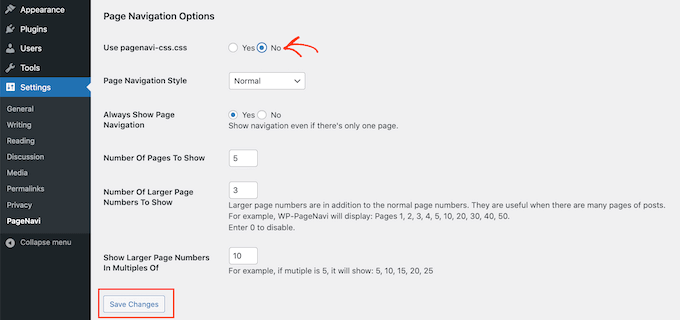
Quindi, andare su Plugin ” Editore di file di plugin.
Si può quindi aprire il menu a discesa “Seleziona plugin da modificare” e scegliere “WP-Page Navi”. Dopodiché, siete pronti a fare clic su “Seleziona”.

Nel menu di destra, fate clic sul file pagenavi-css.css.
Quindi, copiare tutto il codice in questo file.
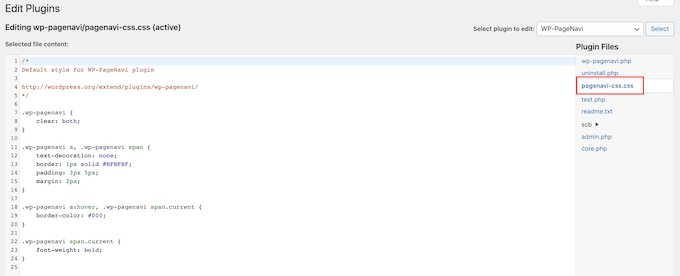
Successivamente, basta andare su Aspetto ” Editore dei file del tema.
Nel menu di destra, fate clic sul file style.css del tema.
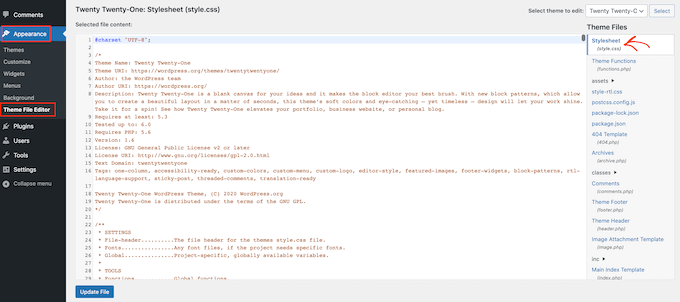
Ora è possibile incollare il codice pagenavi-css.css nel file style.css del tema e iniziare ad apportare le modifiche.
Vediamo un esempio. Ecco una versione modificata del codice di paginazione numerica da aggiungere al file style.css del tema:
1 2 3 4 5 6 7 8 9 10 11 12 13 14 15 16 17 18 19 20 21 22 | wp-pagenavi { clear: both;} .wp-pagenavi a, .wp-pagenavi span { color: #FFF; text-decoration: none; background-color:#6FB7E9; border: 1px solid #B2D1E5; padding: 5px 5px; margin: 2px;} .wp-pagenavi a:hover, .wp-pagenavi span.current { border-color: #E9F2F9; background-color:#6FB7E9;} .wp-pagenavi span.current { font-weight: bold; background-color:#3C8DC5;} |
Nell’immagine seguente, si può vedere come apparirà la paginazione numerica sul sito.
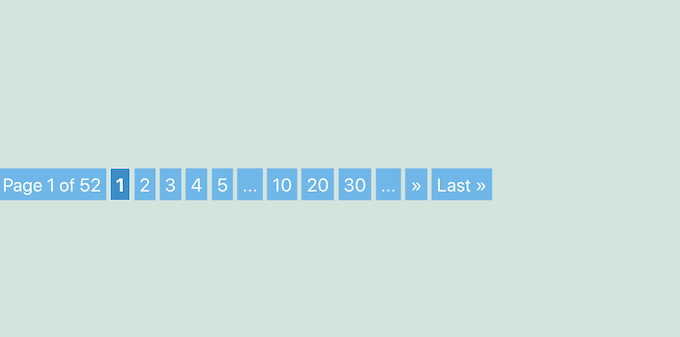
Vale la pena di provare diversi stili per vedere qual è il migliore sul vostro sito web WordPress.
Quando si è soddisfatti dell’aspetto della paginazione numerica, fare clic sul pulsante Aggiorna file per salvare le modifiche.
Metodo 2. Come aggiungere manualmente la paginazione numerica nel tema di WordPress
Un’altra opzione è quella di aggiungere manualmente la paginazione numerica nel tema di WordPress utilizzando il codice.
Molti temi di WordPress sono dotati di collegamenti “Più vecchio” e “Più nuovo” integrati o di una paginazione numerica predefinita. Ad esempio, il popolare tema Astra aggiunge automaticamente la propria paginazione numerica alle pagine degli archivi, come si può vedere nell’immagine seguente.
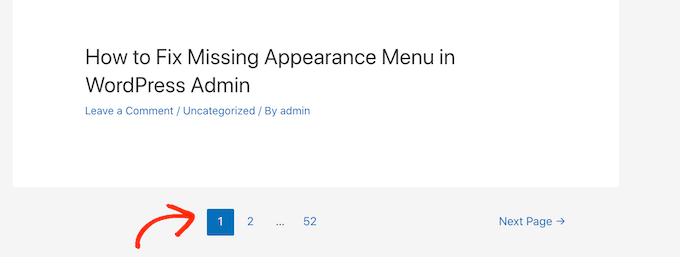
È possibile utilizzare questo metodo per personalizzare la paginazione integrata di un tema. Ad esempio, si può cambiare lo stile per adattarlo meglio al proprio sito.
Per aggiungere manualmente la paginazione numerica, aprire il file functions.php del tema. Qui potete utilizzare un client FTP o il file manager del cPanel del vostro hosting WordPress. Se utilizzate l’FTP, potete consultare la nostra guida completa su come connettersi al vostro sito utilizzando l’FTP.
Una volta effettuata la connessione al sito, aprire il file functions.php e aggiungere il seguente codice:
1 2 3 4 5 6 7 8 9 10 11 12 13 14 15 16 17 18 19 20 21 22 23 24 25 26 27 28 29 30 31 32 33 34 35 36 37 38 39 40 41 42 43 44 45 46 47 48 49 50 51 52 53 54 55 56 57 58 59 60 61 62 63 64 65 66 67 68 | function wpbeginner_numeric_posts_nav() { if( is_singular() ) return; global $wp_query; /** Stop execution if there's only 1 page */ if( $wp_query->max_num_pages <= 1 ) return; $paged = get_query_var( 'paged' ) ? absint( get_query_var( 'paged' ) ) : 1; $max = intval( $wp_query->max_num_pages ); /** Add current page to the array */ if ( $paged >= 1 ) $links[] = $paged; /** Add the pages around the current page to the array */ if ( $paged >= 3 ) { $links[] = $paged - 1; $links[] = $paged - 2; } if ( ( $paged + 2 ) <= $max ) { $links[] = $paged + 2; $links[] = $paged + 1; } echo '<div class="navigation"><ul>' . "\n"; /** Previous Post Link */ if ( get_previous_posts_link() ) printf( '<li>%s</li>' . "\n", get_previous_posts_link() ); /** Link to first page, plus ellipses if necessary */ if ( ! in_array( 1, $links ) ) { $class = 1 == $paged ? ' class="active"' : ''; printf( '<li%s><a href="%s">%s</a></li>' . "\n", $class, esc_url( get_pagenum_link( 1 ) ), '1' ); if ( ! in_array( 2, $links ) ) echo '<li>…</li>'; } /** Link to current page, plus 2 pages in either direction if necessary */ sort( $links ); foreach ( (array) $links as $link ) { $class = $paged == $link ? ' class="active"' : ''; printf( '<li%s><a href="%s">%s</a></li>' . "\n", $class, esc_url( get_pagenum_link( $link ) ), $link ); } /** Link to last page, plus ellipses if necessary */ if ( ! in_array( $max, $links ) ) { if ( ! in_array( $max - 1, $links ) ) echo '<li>…</li>' . "\n"; $class = $paged == $max ? ' class="active"' : ''; printf( '<li%s><a href="%s">%s</a></li>' . "\n", $class, esc_url( get_pagenum_link( $max ) ), $max ); } /** Next Post Link */ if ( get_next_posts_link() ) printf( '<li>%s</li>' . "\n", get_next_posts_link() ); echo '</ul></div>' . "\n"; } |
Questo codice ottiene il numero di pagine, pronto per essere mostrato nel tema di WordPress.
I passi successivi variano a seconda del tema.
Se il tema non ha un modulo di paginazione predefinito, si può semplicemente aggiungere il seguente template nel file index.php, archive.php, category.php o in qualsiasi altra pagina in cui si voglia mostrare la paginazione numerica.
1 | <?php wpbeginner_numeric_posts_nav(); ?> |
Si tenga presente che il punto in cui si aggiunge il codice influisce sulla visualizzazione della paginazione numerica sul sito web.
In genere, si vuole mostrare la paginazione in fondo alle pagine dell’archivio, quindi di solito si vuole aggiungere il template tag al codice del footer.
Il tema ha già qualche modulo di paginazione, come ad esempio i link “Articoli meno recenti” e “Articoli più recenti”?
In questo caso, è necessario trovare il codice di paginazione e sostituirlo con lo snippet qui sopra.
Ad esempio, Ashe è uno dei migliori temi gratuiti per blog WordPress e aggiunge già i link di paginazione “Prima” e “Ultima pagina” alle pagine degli archivi.
Per sostituire questi collegamenti integrati con la paginazione numerica, è necessario modificare i file template/grid.php e template/blog-pagination.php del tema.
In ognuno di questi file, è sufficiente trovare la seguente sezione:
1 | <?php get_template_part( 'templates/grid/blog', 'pagination' ); ?> |
Si può quindi sostituire questa riga con il seguente frammento di codice:
1 | <?php wpbeginner_numeric_posts_nav(); ?> |
Una volta aggiunto il codice, non dimenticate di salvare le modifiche.
Il passo successivo è la creazione di una paginazione numerica personalizzata.
Per aiutare i visitatori a navigare nell’archivio, metteremo in evidenza il numero della pagina corrente con un colore diverso. A tale scopo, aprire il file style.css del tema e incollarvi il seguente codice:
1 2 3 4 5 6 7 8 9 10 11 12 13 14 15 16 17 18 19 20 21 22 23 24 25 26 27 | .navigation li a,.navigation li a:hover,.navigation li.active a,.navigation li.disabled { color: #fff; text-decoration:none;} .navigation li { display: inline;} .navigation li a,.navigation li a:hover,.navigation li.active a,.navigation li.disabled { background-color: #6FB7E9; border-radius: 3px; cursor: pointer; padding: 12px; padding: 0.75rem;} .navigation li a:hover,.navigation li.active a { background-color: #3C8DC5;} |
Dopo tutto ciò, è sufficiente salvare le modifiche facendo clic sul pulsante Aggiorna file.
Ora, se visitate la pagina dell’archivio, vedrete la paginazione numerica in diretta sul vostro sito web.
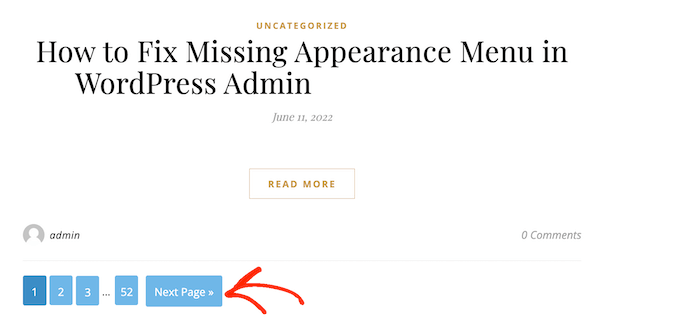
Speriamo che questo articolo vi abbia aiutato a capire come aggiungere la paginazione numerica nel vostro tema WordPress. Potete anche consultare la nostra guida su come fare soldi online facendo blog con WordPress e su come creare un tema personalizzato per WordPress senza scrivere alcun codice.
Se questo articolo vi è piaciuto, iscrivetevi al nostro canale YouTube per le esercitazioni video su WordPress. Potete trovarci anche su Twitter e Facebook.





Tom
You really helpped me. Thanks !
Sam
Thanks very helpful
lucky cabarlo
how can i adjust the numbers to show in the custom numeric pagination
spongie
how do you limit the page number to say up to 2 only then show ellipsis?
krishma
can i use this plugin for custom post type
Astra
Of course mate. You just need to put this code into your page-custom.php
Med
Hello,
I found this very useful and I placed it to my new site. The problem is that it works perfect on the first page of the category, and after clicking on the “Next” link the url changes to /page/2/ but the highlighted page number is aways “1” and the content is always the first 10 articles (always in the first page).
I think there is something missing in my query:
<a href="”>
‘aligncenter’));
} else {
echo ”;
}
?>
Preeti Bhandari
how can i prevent whole page reload when clicking on next link, only want to refresh that particular section… Please help….
Luis Eduardo Braschi
Because “the goal is to replace the default Older and Newer pagination links at the bottom of archive pages” – and this is what “your” function does – “with easy to navigate page numbers.”.
Tony
Hi how do you get just the next and previous links only. thanks.
Barry
How can i use the wpbeginner_numeric_posts_nav(); for my Custom Post type?
I have replaced global $wp_query for
$args = array(
‘post_type’ => ‘my-cpt’,
‘meta_key’=>’cpt_detail’,
‘orderby’=>’meta_value’,
‘order’ => ‘ASC’,
‘paged’ => $paged
);
$cpt_query = new WP_Query($args);
and replaced $wp_query reference with $cpt_query but it doesn’t work
igloobob
Hi, did you ever figure this out please? I’m trying to get this working myself and struggling. Would appreciate your help very much if you got it working…
Ashley Michèlle
Using the ‘wpbeginner_numeric_posts_nav’ method, how would one change the navigation brackets? I’m not a huge fan of the ‘»’.
Thanks!
James George Dunn
Hello Ashley,
You can set a value in the brackets of get_previous_posts_link() and get_next_posts_link(). For example, get_next_posts_link(‘Next Post’) will show “Next Post” instead of the default “Next Page »”.
AmirMasoud
how can i change “Next Page” & “Previous page” text?
TimParkerRD
If you’re using the wpbeginner_numeric_posts_nav function, you can pass custom text to the get_next_posts_links() and get_previous_posts_link(), like so:
get_previous_posts_link(“Go Back”);
Daniel Ortiz
since Genesis Framework is not an open-source framework, are we allowed to use this code, commercially or not?( and are you allowed to distribute it?)
mr anon
thanks a lot
gosukiwi
Awesome, it works like a charm, I did some changes to fix my code though but the code is nice and well organized
Agarwalls
Thanks, Very helpful for me.
SJ
echo paginate_links( $args );
Why this one doesn’t do the job? I’m just curious
SJ
Why this one doesn’t do the job? I’m just curious
Baba agba
I tried it and its not working for me. Can you paste a simple example of your “paginated posts” code here
Nick
Has anyone had any luck getting this working with a custom WP_Query? It works perfect with the standard loop, but does not show up with a custom query. Any help would be great.
Thanks.
Marx
Have you tried the custom query examples noted from the codex?
http://codex.wordpress.org/Function_Reference/paginate_links
Hope that helps.
SJ
Well this one doesn’t work for me Don’t know why
Don’t know why
Mufaddal
Thanks so much, I tried your solution it worked for me.
Timberland
You have 2 options to do that, First is to use query_posts instead of Wp_Query
or the Second is to name your custom query “wp_query” as $wp_query = new WP_Query( $args );
important part in both approaches is to pass the ‘paged’ => $paged argument in your query otherwise won’t work,
//////////////////////////////////////With Wp_Query
$args = array( ‘cat’ => 3, ‘paged’ => $paged );
$wp_query = new WP_Query( $args );
if ( $wp_query->have_posts() ) :
while ( $wp_query->have_posts() ) {
$wp_query->the_post();
get_template_part( ‘content’, get_post_format() ); }
else :
echo “No post to show”;
endif;
wpbeginner_numeric_posts_nav();
wp_reset_postdata(); }
//////////////////////////////////////With Query_Posts
$args = array( ‘cat’ => 3, ‘paged’ => $paged );
query_posts( $args );
if ( have_posts() ) :
while ( have_posts() ) {
the_post();
get_template_part( ‘content’, get_post_format() ); }
else :
echo “No post to show”;
endif;
wpbeginner_numeric_posts_nav();
wp_reset_query(); }
[Hope that helps]
DavidCWebs
Try this native WP function: http://codex.wordpress.org/Function_Reference/paginate_links There’s an example on that codex page showing how to use it with WP_Query.
Hope this helps
Tim
Do this pagination have page number limits or does it automatically detect when more pages are required? Works really nicely
Akash Funde
Thanks for sharing this it helps a lot
Thanks you so Much
adrian
I’ve been using this successful for search results, archives, categories.. but it’s not working for tags. I suspect it could be a permalink issue. The first page works fine, but subsequent pages return 404s. Should this work for tags by default.?
Bubu
search results, archives are ok but in categories same error here. the first page is ok, second page return with 404.
need some help to solve this issue thx
Caroline
Thanks for this, it came in real handy making pagination Foundation framework-ready.
Hiro
I added this to my site and it shows up properly but doesn’t display the proper content on page 2. Tried it both manually and with the plugin. Both times, the pagnation links appear, and when i click to go to page 2, the url changes to page 2 but the content on the page shows only content from page 1 (or index). Please advise
Steve
I am new to Genesis but you say if we are using it that the function is already in there but when I tried adding the php to the hooked area, nothing would display so… I added the above code to my genesis functions.php and added the php call to my hooked area and now the pagination displays but it does not work. When I click the 2nd page, it just reloads the current page.
WPBeginner Support
please contact genesis support
Admin
Tyler
Does this work for wordpress.com sites? I have this blog that is set up via wordpress.com, not the installed version and I need to add pagination for the blog. Is there a way to do that? Thanks for any future help!
WPBeginner Support
No this tutorial is mean for Self hosted WordPress.org sites. As a WordPress.com user you can not directly edit themes.
Admin
Crear Cuenta Outlook
thank you so much
Rajavenkateshwaran
Am facing issues when i use the function within the custom page template. I created a custom page template to loop 4 of the posts, this function works well in Homepage and it doesnshow any sign of navigation links in page template.
Best Regards,
Raja
WPBeginner Support
If you are using a custom WP_Query then please check pagination parameters.
Admin
aklavya
thanx ……………… this code is very helpful
Dejan
Thank you for this code of pagination it is working with WP 3.7.1
Eli Overbey
Any thoughts on how to get archived pagination on Category Blog Page? (in Genesis)
I was able to create a page entitled ‘counseling-blog’, so now we have a Category Blog page at
But here’s the problem… No pagination. The /blog/ has the pagination from Genesis WP. All we have on that new Category Page page is:
”
There is no rel=”next” or rel=”prev”… Any thoughts on how to add next and prev to the Category Blog Page?
I thought the page would add those tags because the template is set as blog.
Big V
Nice post, but I’m having issues with /page/2 not working in my custom theme. Any advice?
Jeremy
WordPress has a core function for doing this.
http://codex.wordpress.org/Function_Reference/paginate_links
Gohar ul Islam
I am searching code (or any kind of help) which uses paginate_links in Wp_query. Do u have any code like this?
Dmitry
Thanks!
Mzer Michael Terungwa
I tried to implement this pagination on the single.php page but it did not show up. Is this only for theme’s index.php, archive.php, category.php, and any other archive page template?
Michael
It appears that Multiple Posts Pagination is quite different from single post pagination and would require different template tags to create them.
WPBeginner Support
Yes this code is only for index and archive pages.
Admin
Felipe Gangrel
Awesome. Thanks a lot!!!
Talha
Great code, thanks bro
Shaghayeggh
Thank you very very much
Marko
Hi,
thanks for great tutorial!
I had to add ul in front of every li in style.css, otherwise this worked perfectly.
(.navigation ul li a,) etc…
elvinson
i have installed wp-pagenavi plugin, but it was not showing in archives , so i have used your coding manually it is working well. Thanks.
Don
what about pagination for a single post that contains numerous pages .. i.e.- this is about A SINGLE POST – that was too long and had to be divided into multiple pages ! … the wp codex for this type of single post pagination is done with the command ( ) … unfortunately none of the plugins out there provides a good solution for this type of pagination ….. or they simple avoid it all together … the wp-pagenavi mentionned it very briefly…. but does not work for single post pagination on 95 % of the wp themes out there….
if there is such a plugin that provides a good alternative for wp_link_pages with good styling and other options for single post pagination …. please share !!!
Editorial Staff
Genesis theme has that option. We are using that on our site http://list25.com/
Admin
Chinmoy Paul
Thanks for sharing this. I will use this in my next project.
Robert Smith
Thanks for this guys! Been looking for a simple solution like this all evening and this was gold!!
Keep up the great work on your site, as it is a regular resource of mine
Thanks,
Rob
Arilton Freitas
To me, the best way to include numeric pagination in WordPress is use the paginate_links() function. Simple and core-based.
http://codex.wordpress.org/Function_Reference/paginate_links
Editorial Staff
Didn’t even know that existed. Thanks for pointing this out.
-Syed
Admin
Mattia
Indeed this is awesome, but… The pagination always appear, also if not needed… Ho do you prevent this?
If mu limit is 10 posts per page, but I only have written 5, the paginations appears and sends me to an empty “page 2″… ;(
Mattia
I checked another of my sites and this error doesn’t appear. In this late site I am building, strangely pagination appears also if not needed! Does someone know which could be the cause? Many thanks!
Jacob
WordPress already has this baked in with a function called paginate_links (http://codex.wordpress.org/Function_Reference/paginate_links).
Upendra Shrestha
Hi, Previously I used wp pagenavi plugin in genesis framework. But it didn’t work with the framework. After adding the code “”, it just worked. I didn’t realize that I had to add this code.
Thanks.
Alex Sancho
and what about the WordPress function paginate_links? http://codex.wordpress.org/Function_Reference/paginate_links
Connie
for those who want to style differently but are not CSS-savy, there are at least 2 additional plugins available:
WP Visual Pagination, http://wordpress.org/extend/plugins/wp-visualpagination/
or
WP PageNavi Style , http://wordpress.org/extend/plugins/wp-pagenavi-style/
Cheers,
Connie
Editorial Staff
Thanks for letting us know Connie.
Admin
Azim
Isn’t it going to be a heavy SQL query, esp. on blogs with lots and lots of posts? I had to get rid of such pagination on one of my projects (containing over 10K posts), because hoster claimed it consumed too much of a CPU and SQL resources. Basically, what it did is selected ALL posts (over 10K, remember?) and then just divided them into multiple pages with 20 (or whatever you specify in admin) posts per page…
Editorial Staff
WordPress is dividing the posts in those pages to begin with using the WP_Query posts_per_page parameter. All this query is doing is looking at those pages and creating a numeric display. I’m sure there was more going on that your host didn’t bother explaining.
-Syed
Admin